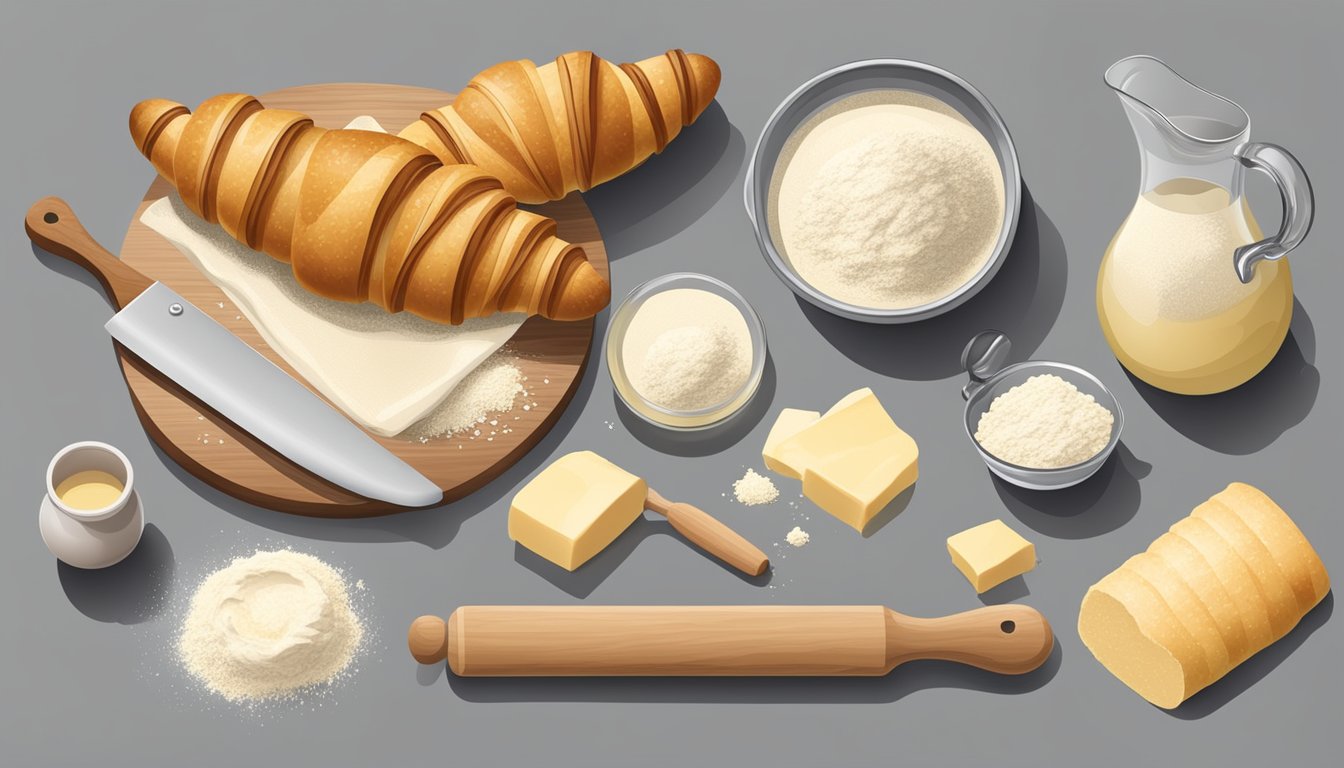Homemade breakfast croissants are a delightful way to start the day, offering a taste of French bakery indulgence in the comfort of your own kitchen. To make croissants from scratch, bakers need to master the lamination technique, which involves folding butter into dough repeatedly to create the signature flaky layers. This process requires patience and precision but results in pastries far superior to store-bought alternatives.
The journey to perfect homemade croissants begins with a simple dough made from flour, yeast, milk, and a touch of sugar. After an initial rise, the dough is combined with a layer of butter through a series of folds and turns. This lamination process is key to achieving the desired texture and buttery flavor that defines a true French croissant.
Essential Ingredients
Creating perfect homemade croissants requires high-quality ingredients and precise measurements. The right combination of flour, yeast, butter, salt, and sugar is crucial for achieving the desired flavor and texture.
Choosing the Right Flour
All-purpose flour is the standard choice for croissants. It contains moderate protein content, typically between 10-12%, which provides the necessary gluten structure. This protein level allows for proper dough development while maintaining a tender crumb.
For best results, use unbleached all-purpose flour. It retains more of its natural flavor and color compared to bleached varieties. Some bakers prefer bread flour for extra strength, but it can make the croissants slightly chewier.
Measure flour accurately using the spoon-and-level method or a kitchen scale for consistency. Proper flour measurement ensures the correct dough hydration and texture.
The Role of Yeast
Yeast is essential for leavening croissants and providing flavor. Two common types are active dry yeast and instant yeast. Active dry yeast requires proofing in warm liquid before use, while instant yeast can be added directly to dry ingredients.
For 4 cups of flour, use about 2 1/4 teaspoons of active dry yeast or 1 3/4 teaspoons of instant yeast. Ensure the yeast is fresh for optimal performance. Store unopened yeast in a cool, dry place and opened yeast in the refrigerator.
Water temperature is crucial when activating yeast. Use liquid between 105°F and 115°F (40°C to 46°C) to avoid killing the yeast or slowing its growth.
Types of Butter for Lamination
Butter quality significantly impacts croissant flavor and texture. European-style butter, with its higher fat content (82-86%), is ideal for lamination. It creates distinct layers and a richer taste compared to standard butter (80% fat).
Unsalted butter is preferred as it allows better control over the total salt content in the recipe. Look for butter with a pale yellow color and a fresh, clean aroma.
For lamination, butter should be pliable but cool. Soften it to about 60°F (15°C) before incorporating it into the dough. This temperature allows for easy spreading without melting, ensuring distinct layers in the final product.
Salt and Sugar Measurements
Salt enhances flavor and strengthens gluten structure in croissants. Use fine sea salt or table salt for even distribution. For 4 cups of flour, add about 1 1/2 teaspoons of salt.
Sugar contributes to flavor, browning, and fermentation. It provides food for the yeast and helps tenderize the dough. Use granulated sugar for its fine texture. Add about 1/4 cup of sugar per 4 cups of flour.
Adjust salt and sugar amounts slightly based on personal preference, but avoid significant changes as they can affect the dough’s behavior and final texture.
Preparing the Dough
Creating the perfect croissant dough requires precision and patience. The process involves carefully combining ingredients, kneading to develop gluten, and allowing proper rest time for optimal texture and flavor.
Mixing the Ingredients
Begin by gathering high-quality flour, active dry yeast, sugar, salt, milk, and unsalted butter. In a large mixing bowl, combine the flour, sugar, and salt. Warm the milk to 110°F-115°F and dissolve the yeast in it with a pinch of sugar. Let the mixture sit for 5-10 minutes until foamy.
Create a well in the center of the dry ingredients and pour in the yeast mixture. Add softened butter and mix until a shaggy dough forms. Use a wooden spoon or dough hook attachment on low speed to incorporate all ingredients thoroughly.
Tip: Ensure all ingredients are at room temperature for even mixing.
The Kneading Process
Transfer the dough to a lightly floured surface. Knead for 8-10 minutes until smooth and elastic. The dough should be soft but not sticky. If it’s too wet, add small amounts of flour as needed.
To test if the dough is ready:
- Perform the windowpane test: Stretch a small piece of dough. It should form a thin, translucent membrane without tearing.
- Press the dough gently with a finger. It should spring back slowly.
For machine kneading, use a stand mixer with a dough hook on medium speed for 5-6 minutes.
Dough Resting Time
Place the kneaded dough in a lightly greased bowl. Cover with plastic wrap or a damp cloth. Let it rest at room temperature for 1-2 hours or until doubled in size.
After the initial rise, punch down the dough gently to release excess gas. Shape it into a rectangle and wrap tightly in plastic. Refrigerate for at least 4 hours or overnight.
This cold fermentation period is crucial for:
- Developing flavor
- Relaxing gluten
- Chilling the dough for easier lamination
Remember, patience during the resting phase leads to superior texture and taste in the final croissants.
Laminating the Dough
Laminating dough is a crucial technique for creating flaky, layered croissants. This process involves folding butter into the dough repeatedly to create alternating layers.
Creating the Butter Layer
Begin by shaping cold butter into a flat rectangle. Aim for a thickness of about 1/4 inch. Wrap the butter block in parchment paper and chill it until firm. Roll out the dough into a rectangle approximately twice the size of the butter block. Place the chilled butter in the center of the dough.
Fold the dough over the butter, completely encasing it. Pinch the edges to seal. This creates the initial butter layer within the dough.
Folding and Turning
Roll the dough-butter package into a long rectangle, about 1/4 inch thick. Fold it into thirds, like a letter. This completes one “turn”. Wrap the dough and refrigerate for 30 minutes to 1 hour.
Repeat this process 3-4 more times, chilling between each turn. With each fold, you multiply the number of butter layers in the dough.
Achieving Flaky Layers
The key to flaky layers is maintaining distinct butter sheets within the dough. Keep the dough and butter cold throughout the process. If the butter melts, it will incorporate into the dough instead of forming separate layers.
Roll with even pressure to ensure uniform thickness. Dust off excess flour between folds to prevent dry spots in the finished croissants.
After the final turn, refrigerate the laminated dough overnight. This resting period allows the gluten to relax, making the dough easier to shape and ensuring a better rise during baking.
Shaping the Croissants
Shaping croissants requires precision and technique to achieve the classic crescent form with flaky layers. The process involves cutting the dough, rolling triangles, and allowing time for proofing.
Cutting and Triangles
Start with the chilled dough rolled into a large rectangle. Trim the edges to create clean lines. Using a sharp knife or pizza cutter, slice the dough into long triangles. Each triangle should measure about 10 inches long and 4 inches wide at the base. Make a small cut in the center of the wide end to help create the crescent shape.
For even baking, ensure all triangles are uniform in size. Separate the cut triangles and place them on a lightly floured surface. Keep unused dough refrigerated to maintain the butter’s firmness.
Rolling Technique
Place a triangle on the work surface with the wide end facing you. Gently stretch the dough, elongating it slightly. Begin rolling from the wide end, keeping the roll tight but not too compressed. Apply light, even pressure as you roll towards the pointed end.
Slightly curve the ends inward to form the classic crescent shape. Place the shaped croissants on a parchment-lined baking sheet, ensuring the pointed end is tucked underneath to prevent unraveling during baking.
Leave space between each croissant for expansion during proofing and baking.
Proofing the Croissants
Proofing is crucial for developing the croissants’ flaky texture. Cover the shaped croissants with a clean kitchen towel or plastic wrap. Let them proof at room temperature for 1-2 hours, depending on the warmth of your kitchen.
The croissants should nearly double in size and feel puffy when gently touched. Avoid overproofing, as this can lead to collapsed pastries during baking.
For a golden finish, brush the proofed croissants with egg wash just before baking. This step enhances their appearance and creates a crisp exterior.
Baking and Finishing Touches

Proper baking technique is crucial for achieving perfectly golden, flaky croissants. The right oven temperature, egg wash application, and timing are key to success.
Correct Oven Temperature
Preheat the oven to 200°C (400°F). This high temperature is essential for creating the crisp exterior and soft, layered interior of croissants. Use an oven thermometer to ensure accuracy, as ovens can vary. Place the baking sheets in the center of the oven for even heat distribution.
For convection ovens, reduce the temperature by 25°F (about 15°C). This adjustment accounts for the increased efficiency of hot air circulation.
Applying Egg Wash
Prepare the egg wash by whisking one egg with a tablespoon of water. This mixture gives croissants their signature golden sheen. Use a pastry brush to apply a thin, even layer over the entire surface of each croissant.
Be careful not to let excess egg wash pool at the base of the pastries, as this can interfere with proper rising. For a richer color, some bakers add a pinch of salt or a drop of cream to the egg wash.
Final Baking Steps
Place the egg-washed croissants on parchment-lined baking sheets, leaving ample space between each pastry. Bake for 20-22 minutes, rotating the sheets halfway through for even browning.
Watch closely in the final minutes to prevent over-baking. Croissants are done when they’re deeply golden brown and feel light when lifted.
Allow the freshly baked croissants to cool on a wire rack for 10-15 minutes before serving. This cooling period helps set the layers and complete the baking process.
Variations and Fillings

Croissants offer a versatile canvas for both sweet and savory flavors. Chocolate, cheese, and deli meats are popular additions that transform the classic pastry into exciting new creations.
Chocolate Croissants
Chocolate croissants, also known as pain au chocolat, are a beloved variation. To make them, place a strip of high-quality dark chocolate along the edge of the dough before rolling. As the croissant bakes, the chocolate melts, creating a decadent center.
For extra indulgence, drizzle melted chocolate over the baked croissants. Some bakers add a sprinkle of sea salt to enhance the chocolate flavor.
Croissant Sandwiches
Croissant sandwiches elevate breakfast and lunch options. Slice a baked croissant horizontally and fill it with your favorite ingredients.
Classic combinations include:
- Ham and sharp cheddar cheese
- Turkey and Swiss cheese
- Egg and bacon
For a quick breakfast sandwich, add a fried egg, cheese, and a slice of crispy bacon. Toasting the croissant lightly adds a pleasant crunch.
Savory Additions
Savory croissants offer a delightful twist on the traditional recipe. Incorporate cheese, herbs, or cured meats directly into the dough before shaping and baking.
Try these savory variations:
- Gruyère and thyme
- Prosciutto and parmesan
- Spinach and feta
For a cheesy option, sprinkle grated Gruyère or sharp cheddar on top of the croissant before baking. The cheese will melt and create a crispy, golden crust.
Storing and Reheating
Proper storage and reheating techniques are crucial for maintaining the quality of homemade breakfast croissants. These methods help preserve the buttery texture and flaky layers that make croissants so delightful.
Optimal Storage Techniques
Store freshly baked croissants at room temperature for 1-2 days in an airtight container or plastic bag. This preserves their crisp exterior and soft interior. For longer storage, freeze croissants for up to 2 months.
To freeze, wrap each croissant individually in plastic wrap or aluminum foil. Place wrapped croissants in a freezer-safe bag, removing as much air as possible before sealing.
For filled croissants, refrigerate within 2 hours of baking. Use airtight containers to prevent absorption of other food odors. Consume refrigerated croissants within 3-5 days for best quality.
Best Reheating Methods
Oven reheating is ideal for restoring the croissants’ crispy texture. Preheat the oven to 300°F (150°C). Place croissants on a baking sheet and heat for 5-7 minutes until warm and crisp.
For a quicker option, use a toaster oven. Set to medium heat and warm for 2-3 minutes. Watch closely to prevent burning.
Microwave reheating is fastest but can make croissants soggy. Wrap in a damp paper towel and heat for 10-15 seconds. Let stand for a minute before eating.
To reheat frozen croissants, thaw at room temperature for 30 minutes. Then use the oven method, increasing time to 7-10 minutes.
Nutritional Information

Breakfast croissants can vary significantly in nutritional content depending on ingredients and preparation methods. A typical homemade croissant sandwich contains approximately 500-700 calories.
Croissants are high in fat, with about 45-50% of calories coming from fat sources. Saturated fat content is often elevated due to butter in the pastry.
Protein content ranges from 15-25 grams per sandwich, influenced by ingredients like eggs, ham, and cheese. Carbohydrates usually account for 30-40% of total calories.
Sodium levels can be high, often exceeding 800mg per serving. This is primarily from cheese, ham, and added salt.
Key nutrients found in breakfast croissants include:
- Calcium: 15-20% Daily Value (DV)
- Iron: 10-15% DV
- Vitamin A: 10-15% DV
- Vitamin B12: 15-20% DV
Fiber content is generally low, typically 1-3 grams per sandwich. Adding vegetables can increase fiber and nutrient density.
To reduce calorie and fat content, consider using whole grain croissants, lean proteins, and reduced-fat cheeses. Incorporating vegetables like spinach or tomatoes can boost nutritional value without significantly increasing calories.
Useful Baking Tools and Resources
The right equipment and instructional materials can elevate your croissant-making experience. Quality baking sheets and informative video tutorials are essential for achieving delicious homemade French croissants.
Recommended Baking Sheets
Invest in heavy-duty, commercial-grade aluminum baking sheets for optimal results. These sheets distribute heat evenly, promoting uniform browning of your croissants. Look for rimmed sheets measuring 18 by 13 inches, which provide ample space for multiple croissants.
Non-stick surfaces can be helpful, but aren’t necessary if you use parchment paper. Avoid dark-colored or insulated baking sheets, as they may affect baking times and results.
For authentic French croissants, consider double-layered perforated baking sheets. These allow air circulation, creating a crisp bottom crust.
Online Video Tutorials
Video tutorials offer visual guidance for mastering croissant-making techniques. Seek out reputable sources featuring professional bakers or culinary schools.
Look for tutorials that cover the entire process, from making the dough to shaping and baking. Pay special attention to videos demonstrating lamination techniques, as this is crucial for achieving flaky layers.
Some tutorials focus on using European-style butter, which has a higher fat content ideal for authentic French croissants. These can be particularly helpful for achieving professional results.
Be wary of overly simplified tutorials. Croissant-making is a skill that requires attention to detail and practice.




